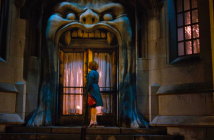
Fifty Shades of Grey
Cast: Dakota Johnson, Jamie Dornan, Jennifer Ehle
Director: Sam Taylor-Johnson
Country: USA
Genre: Drama | Romance
Editor’s Notes: Fifty Shades of Grey opens in wide release tomorrow, February 13th.
The only discernible difference between a Disney fairy tale and Fifty Shades of Grey is…ya know…the blindfolds and handcuffs and leather floggers. Rather than a crown of jewels, this story deals in pearl necklaces – although even that seems out of this film’s realm, which is more an environment of chaste courtship posing as dark deviance. Regardless of the comparative salaciousness of its source material, this film adaptation is at once sexually toothless and emotionally dangerous, pulling its punches (or spanks, I guess) in favor of butterfly kisses, but dealing in enough seedy material to create the most insidiously murky storybook romance in modern history.
Regardless of the comparative salaciousness of its source material, this film adaptation is at once sexually toothless and emotionally dangerous …
Why insidious? Why dangerous? One need look no further than the New York Times bestseller charts, where E.L. James’ trio of Grey “novels” (which read more like “Word Bird’s Nighttime Fantasies”) became an incredible sensation with, for lack of a better term, the “Desperate Housewives” demo. Even that notion feels ignorantly reductive, but it’s actually the fault of the books, which encourage grown women to revel in a soap opera of clichéd fantasies and wade in a shallow pool of “desirable” sexual violence while eventually landing safely on the cushy ground of tepid romance. Cuz, ya know, that’s always how it works.

Leave it to me to draw a parallel between two seemingly disparate works, but there is an interesting link between Fifty Shades and Clint Eastwood’s American Sniper (other than the fact that they both feature my high school buddy and onetime screenwriting cohort Luke Grimes, who is great in Sniper and criminally underused in this film). In my Sniper review a couple weeks ago, I noted how, in spite of the perfectly correct notion that a film is a separate work from its source material and even from the public reaction to it, one really couldn’t discuss the film without also discussing its larger social context. Same goes for Fifty Shades of Grey – except instead of inciting the violent fantasies of fringe right-wingers, James’ books, and presumably this inevitably popular movie, will inspire legions of women to project a desire to be dominated by a cold, aberrant man…all from the comfort of their cinema seat. But just like a rooftop snipe doesn’t end a war, a deep-dive into S&M won’t result in a kindly revelation of past pain that opens the window for a woman to fix the poor man’s psyche and heal his wounded soul.
Fifty Shades of Grey is only about the surface image of unorthodox sex, about how the whips and chains and handcuffs are merely a constructed wall that can be toppled like any other.
Uh oh…did I give anything away? Surely we are all self-aware enough to know the score, aren’t we? Fifty Shades of Grey is only about the surface image of unorthodox sex, about how the whips and chains and handcuffs are merely a constructed wall that can be toppled like any other. For in this story, Prince Charming is truly the one blindfolded and shackled; it’s Cinderella’s job to pull the diamond from the rough. Wonderful message, right ladies? Lots of truth there, in your experience?
“Cinderella,” in this twisted version of the tale, is the soap-tastically named Anastasia Steele, played in the film by Dakota Johnson, who is actually quite great. She’s wide eyed and vulnerable, with great timing, both comedic and dramatic. There’s real talent brewing, which shines through even the heavy limits of this narrative, which requires her to bite her lip in nearly every scene. Anastasia is basically a child – “barely legal,” as it were – and a virgin to boot (so there’s some gross fantasy material for the unsavory men in the audience, too). She meets Christian Grey (Jamie Dornan, who also acquits himself fairly well under the circumstances) by uber-convenient narrative design, stepping in for her sick friend to conduct an interview for a college newspaper. What does Grey do, exactly, that has resulted in him becoming an unattainable billionaire? Um…not sure, really, but apparently it results in some incredible humanitarian pursuits (because, of course). A single discussion with the titular hunk results in poor Anastasia going weak at the knees – and of course, the requisite biting of the lip. Not sure if it’s just Ana’s reaction – since Grey’s bevy of icy supermodel assistants seem fairly autonomous, in an asexual, robotic sense – but I suppose it should be understood that the young businessman has a way of engendering this reaction from any unsuspecting woman.
Subsequent meetings result in additional lip biting, and reveal Grey as not merely intimidating, but mildly stalker-ish and openly fathering. And thus, the ultimate Anastasia-Christian dynamic is set in motion: he’s her father and she is his weak wallflower of a daughter. Gross. Poor Dakota Johnson is made to not only bite her lip, but also strut around in pigtails and drink out of a bowl – so she’s either a kid or a kitten, and either analogy works in the film’s parlance. Dornan’s role consists of rescuing the virginal princess from a drunken stupor, catching her when she faints, and then engaging in discussions of a formal contractual agreement by which she would essentially become his slave (“submissive” in the film’s whitewashed terminology), living in a sterilized room in his posh penthouse and being at the ready to service him in any creatively abusive manner he chooses in a locked-away, red-tinted “Playroom.” Of course, this is all, according to Grey, “for your pleasure, Anastasia.”
But that contract thing never actually gets signed. We get a lot of conversation about said contract, but all on-screen action seems much more in line with a typical rom-com, and this one is gold-plated, since Grey’s billionaire status affords these characters whatever luxurious dalliance they desire – which, let’s be honest, is the real fantasy at work in the story. Being “in the black” is far more alluring than wearing black leather.
The inherent sexual appeal of financial solvency is merely one of the cultural clichés that Fifty Shades of Grey – the film and the franchise – propagates, however. Such a widespread cultural phenomenon can only result from capitalizing on a perceived weakness or absence of something from the lives of its audience members. It’s no different from any other market blitz: it’s a substitution game. “Missing X? Well, here’s Y.” For the millions of mature adult women who have flocked to this story, embraced it like a new fringe gospel, and exchanged frayed copies of the books like teenage boys passing around a ratty copy of Playboy in the school hallway, are they really wanting to be dominated in a haute couture sexual dungeon? Get real. What they want, what’s really missing, is a venue by which they are free to act like those aforementioned teenage boys. It’s not about this particular psychosexual outlet, but having any sort of outlet at all. Men are constantly afforded said outlets, and more often than not they are at the expense of women. Men are the actors and women are the objects. So now, women read Fifty Shades of Grey so they can have water cooler discussions similar to the male-centered “locker room” discussions. They pack screenings of Magic Mike in order to co-opt the traditionally male pastime of ogling the sex object while high-fiving and hollering. But life isn’t merely contained inside the pages of a book, or within the frame of a cinema screen. So once this behavior is viewed outside of that context, all of a sudden it’s odd, or silly, or so discordant with societal norms that it makes the “average” person scoff and roll their eyes. Because for men, “deviant” is normal, and for women, “overstepping boundaries” is deviant.
Playing into that social rift is Fifty Shades of Grey’s nastiest sin. It purports to set female sexuality free, but it actually tightens the shackles.
Playing into that social rift is Fifty Shades of Grey’s nastiest sin. It purports to set female sexuality free, but it actually tightens the shackles.




Pingback: Google()
Pingback: digital signature for resume()
Pingback: miniclip()
Pingback: http://www.menage-poly.com()
Pingback: Shoe cleaner and conditioner()
Pingback: http://blackjackonline.us.org/()